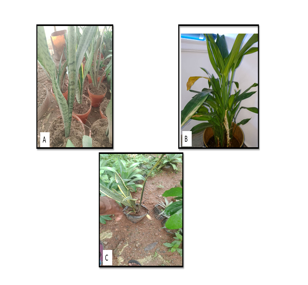Improvement of indoor air quality of selected workspaces using phytopurification techniques
Main Article Content
Abstract
Good indoor air quality improves productivity at the workplace and on the other hand, poor indoor air quality could lead to losses in productivity as a result of comfort problems, ill health, and sickness- absenteeism. The purpose of this study was to improve indoor air quality using phytopurification techniques by monitoring and comparing the Indoor Air Quality before and after the use of some indoor plants in the selected workspaces in Lead City University Area, Ibadan, Oyo State. Various parameters such as Temperature, Formaldehyde, Relative humidity(RH), Fine particulate matter (PM2.5), Total Volatile Organic Compounds(TVOC), Carbon monoxide, Carbon dioxide(CO2), and Air quality Index(AOI), were measured before and after indoor plant placement and the microbial quality (fungal and bacterial) were all determined. Temperature, formaldehyde, CO2, and PM2.5 level for the offices studied were relatively low and were within WHO acceptable range, yet there were noticeable variations inRH, TVOC, CO2, and AQI levels in some specific offices. The introduction of inoculated indoor air plant demonstrated high potential of mitigating the variations noticed before their administration. This supports indoor plants’ role in managing indoor air pollution. The study further concludes that a successful application of indoor plant can potentially contribute to sustainable indoor air pollution control. Recommendation from this study includes deployment of genetically characterized biological agents that contributed significantly to indoor pollution control in this study to workspaces for a more comfortable and conducive indoor environment for its occupants, promoting well-being and productivity.
Metrics
Article Details

This work is licensed under a Creative Commons Attribution-NonCommercial 4.0 International License.
References
Sadrizadeh S, Yao R, Yuan F, Awbi H, Bahnfleth W, Bi Y, Cao G, Croitoru C, de Dear R, Haghighat F, Kumar P, Malayeri M, Nasiri F, Ruud M, Sadeghian P, Wargocki P, Xiong J, Yu W, Li B. Indoor air quality and health in schools: A critical review for developing the roadmap for the future school environment. J. Build. Eng. 2022; 57: 104908. ISSN 2352-7102. doi: 10.1016/j.jobe.2022.104908.
Nassikas NJ, McCormack MC, Ewart G, Balmes JR, Bond TC, Brigham E, Cromar K, Goldstein AH, Hicks A, Hopke PK, Meyer B, Nazaroff WW, Paulin LM, Rice MB, Thurston GD, Turpin BJ, Vance ME, Weschler CJ, Zhang J, Kipen HM. Indoor Air Sources of Outdoor Air Pollution: Health Consequences, Policy, and Recommendations: An Official American Thoracic Society Workshop Report. Ann Am Thorac Soc. 2024; 21(3):365-376. doi: 10.1513/AnnalsATS. 202312-1067ST. PMID: 38426826; PMCID: PMC10913763.
Vardoulakis S, Giagloglou E, Steinle S, Davis A, Sleeuwenhoek A, Galea KS, Dixon K, Crawford JO. Indoor exposure to selected air pollutants in the home environment: a systematic review.Int. J. Environ. Res. Public Health. 2020; 17(23):8972.
Dutkiewicz J, Cisak E, Sroka J, Wójcik-Fatla A, Zajac V. Biological agents as occupational hazards–selected issues. Ann. Agric. Environ. Med.. 2011; 18:286-93.
Gibbons SM, Gilbert JA. Microbial diversity–exploration of natural ecosystems and microbiomes. Curr. Opin. Genet. Dev. 2015;35:66-72.
Li K, Bihan M, Yooseph S, Methe BA. Analyses of the microbial diversity across the human microbiome. PLoS ONE. 2012; 7:32118.
Surtees R, Ariza A, Punch EK, Trinh CH, Dowall SD, Hewson R,Hiscox JA, Barr JN, Edwards TA. The crystal structure of the Hazara virus nucleocapsid protein. BMC Struct. Biol. 2015;15:1-3.
CrameriR. Recombinant Aspergillus fumigatus allergens: From the nucleotide sequences to clinical applications. Int. Arch. Allergy Immunol. 2018, 115, 99–114.
Holst GJ, Pedersen CB, Thygesen M, Brandt J, Geels C, Bønløkke JH, Sigsgaard T. Air pollution and family related determinants of asthma onset and persistent wheezing in children: nationwide case-control study. bmj. 2020; 19;370.
Vardoulakis S, Giagloglou E, Steinle S, Davis A, Sleeuwenhoek A, Galea KS, Dixon K, Crawford JO. Indoor exposure to selected air pollutants in the home environment: a systematic review. Int. J. Environ. Res. Public Health . 2020; 17(23):8972.
Sparks K, Faragher B, Cooper CL. Well-being and occupational health in the 21st century workplace. J Occup Organ Psychol. 2001; 74:487-509.
World Health Organization. Ambient air pollution. A global assessment of exposure and burden of disease. Geneva, Switzerland. W.H.O.; 2016. p. 1-121.
Nutbeam D, Lloyd JE. Understanding and responding to health literacy as a social determinant of health. Annu. Rev. Public Health. 2021; 42(1):159-73.
Gou Z, Lau SS. Sick building syndrome in open-plan offices. J Facilities Manag. 2012; 10:256-65.
Jim CY, Chen WY. Assessing the ecosystem service of air pollutant removal by urban trees in Guangzhou (China). J. Environ. Manag. 2018; 88;665-76.
Song JE, Kim YS, Sohn JY. The impact of plants on the reduction of volatile organic compounds in a small space. J Physiol. Anthropol. 2017; 26:599-603.
Teiri H, Hajizadeh Y, Azhdarpoor A. A review of different phytoremediation methods and critical factors for purification of common indoor air pollutants: an approach with sensitive analysis. Air Qual. Atmos. Health. 2021:1-9.
Oyabu, T., Sawada, A., Onodera, T., Takenaka, K., and Wolverton, B. Characteristics of potted plants for removing offensive odors: Sens. Actua. B. Chemical. 2017; 88; 131-136.
Mata TM, Oliveira GM, Monteiro H, Silva GV, Caetano NS, Martins AA. Indoor air quality improvement using nature-based solutions: design proposals to greener cities. Int. J. Environ. Res. Public Health. 2021; 11;18(16):8472.
Molina L, Wittich RM, van Dillewijn P, Segura A. Plant-bacteria interactions for the elimination of atmospheric contaminants in cities. Agronomy. 2021; 6;11(3):493.
Haslett SL, Thomas JC, Morgan WT, Hadden R, Liu D, Allan JD, Williams PI, Keita S, Liousse C, Coe H. Highly controlled, reproducible measurements of aerosol emissions from combustion of a common African biofuel source. Atmos. Chem. Phys. 2018; 18(1):385-403


